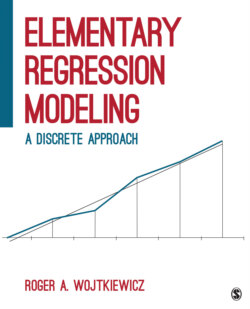Читать книгу Elementary Regression Modeling - Roger A. Wojtkiewicz - Страница 30
На сайте Литреса книга снята с продажи.
Differences
ОглавлениеTable 2.7
Taking a difference between two means involves subtracting one mean from the other mean. The difference shows how much one mean is more or less than the other mean. The order of subtraction matters for interpretation. The sign of the difference will reverse if the order of subtraction is reversed. Of course, if the magnitude of the difference is measured by absolute value, then the difference will not change when the order of subtraction is changed:
When only two means are involved in the analysis, reversing the order of subtraction simply reverses the sign of the difference. The mean for those in private schools is 5.06 and is larger than the mean for those in public schools. Those respondents in private schools have a higher mean math score than those in public schools, or those in public schools have a lower mean math score than those in private schools.
We usually analyze a cross-tabulation by using percentages rather than log odds. However, as preparation for understanding logistic regression, I analyze the cross-tabulation in Table 2.9 by using log odds. Those students in private school are more likely to be in the top 25% on math score than those in public schools, −.45 compared with −1.25:
Table 2.8 Differences in Mean Math Score by Type of School
Table 2.9
Table 2.10
The difference in log odds is .80 for the private school log odds minus the public school log odds and –.80 for public minus private. Reversing the order of subtraction only results in a reversal of the sign of the difference between log odds. The order of subtraction does not matter much in understanding the information provided when comparing two groups.
The challenge in analyzing differences in means for the four family structure categories shown in Table 2.11 is to decide which differences to focus on. Changing the contrast group changes the differences:
Table 2.11
Table 2.12 Differences in Mean Math Score by Family Structure
With four categories in the family structure variable, there are 12 possible differences but only 6 unique ones. In each column, the mean for a different group is subtracted. Each column represents a different set of differences. The mean differences in the top half of the matrix reflect the bottom half but with a change in sign.
Table 2.13
Since only one set of differences is usually considered, a key decision in the analysis of differences is which mean or log odds will be the one that is subtracted. Standard practice is to use mean or log odds for the most analytically important group when subtracting:
Since the differences are calculated as the difference from some particular group, the group chosen as the one subtracted is a key decision. All the differences reflect how the means or log odds compare with that one contrast group.
Table 2.14
